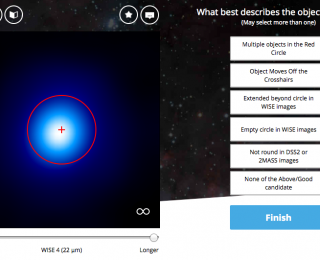
by Erika Nesvold | Feb 2, 2014 | Current Events
Finding circumstellar disks in the Wide-Field Infrared Survey Explorer data is a tough job, but fortunately our brains are even better suited to the task than computers! You can help by lending your pattern-recognition skills to Disk Detective, the Zooniverse’s newest citizen science project.
by Erika Nesvold | Jan 18, 2014 | Daily Paper Summaries
Title: Superhabitable Worlds Authors: René Heller and John Armstrong First Author’s Institution: McMaster University Status: Published in Astrobiology Note: This journal article covers two topics that we thought each deserved its own astrobite. Yesterday’s astrobite discussed the first half of the paper, about the effects of tidal heating on habitability. Today’s astrobite explores the concept of superhabitability.Introduction to SuperhabitabilityLet’s talk about the Copernican principle. This idea states that we (humans, Earth, the Solar System, etc) are not special. We’re not the center of the universe, and there’s no particular reason to believe that we’re unique in the Universe. We’re just average, middle-of-the-road, ordinary. In a lot of cases this has turned out to be true — Earth is not the center of the Solar System, the Solar System is not the center of the Galaxy, and the Milky Way Galaxy is only one of many. So this concept is really useful when trying to understand cosmology, but what does it mean in the context of our search for habitable worlds? The Copernican principle would imply that the reason life exists on Earth is not because Earth is a unique, magical place. Instead, life exists on Earth because Earth happens to have the right physical conditions to allow life to evolve, and those physical conditions probably exist elsewhere, too. So our search for “habitable” worlds is often conflated with a search for “Earth-like” worlds — planets and moons with the same size, density, and surface temperature as Earth.But what if we’re not average? What if Earth isn’t your standard suburb of habitability, but actually a rough neighborhood, habitable-but-only-barely? In an...

by Erika Nesvold | Jan 17, 2014 | Daily Paper Summaries
Today’s paper is too awesome to be contained in merely one astrobite, so we’ve split it into two parts. In Part 1, find out how you can keep warm even if you’re far outside your star’s habitable zone (if “you” are a planet or moon, that is). Tune in tomorrow for Part 2: Superhabitability and You!

by Erika Nesvold | Dec 13, 2013 | Daily Paper Summaries
The Magellan telescope has directly imaged a planetary-mass companion at a projected distance of 650 AU from its star! Read on to find out how the authors detected and characterized this companion, and how they think it got there.

by Erika Nesvold | Nov 15, 2013 | Daily Paper Summaries
Can life spread from Earth to the moons of Jupiter and Saturn on rock ejected from meteoroid collisions? The authors of this paper start on answering this question by asking if ejected material from Earth can even reach the gas giants’ moons. The answer is yes, so it’s possible that microbial Earthlings have already traveled a lot farther than human ones.




